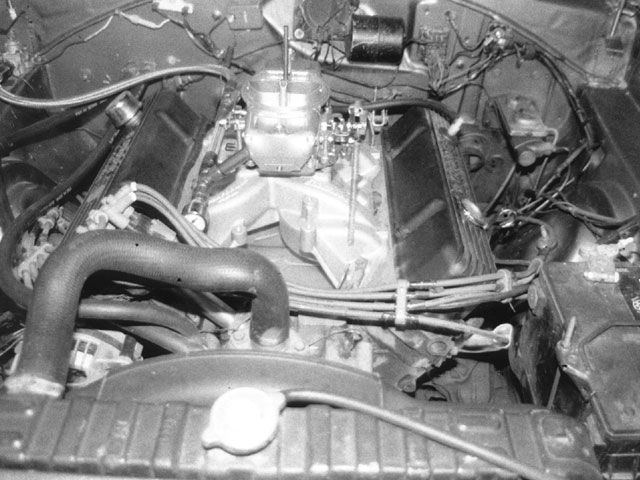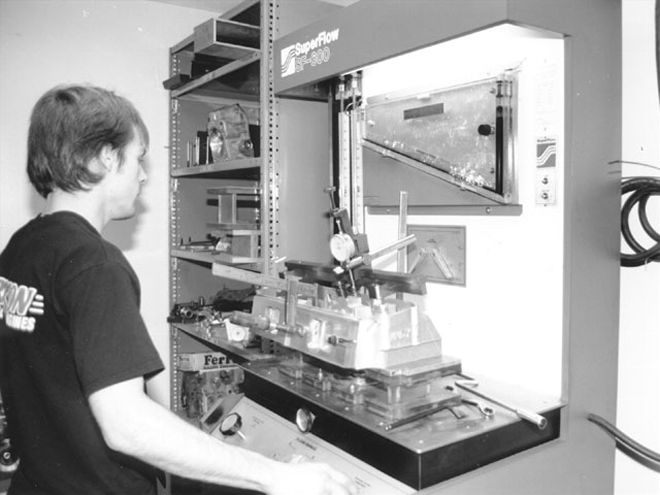
 Mike Barton of RBRE handled the flowbench duties for the Indy SRs. Having records of the many Indy heads they have already flowbenched, we were pleased with the flow numbers after our porting efforts. The Indy SR heads really came alive after we opened up the intake openings to the Max Wedge size.
Mike Barton of RBRE handled the flowbench duties for the Indy SRs. Having records of the many Indy heads they have already flowbenched, we were pleased with the flow numbers after our porting efforts. The Indy SR heads really came alive after we opened up the intake openings to the Max Wedge size.
All it took was a call from a long-time Mopar friend, Vic Palumbo. "Hey Dan, I bought a set of Indy SR [Stock Replacement] heads. Could you port and bolt 'em on my '67 GTX?" My reply: "Sure Vic-providing we could use your car for testing. The Indy SRs would have to prove themselves against a set of 906 heads with the typical modifications." Vic didn't realize the change would require new headers and an installation kit from Indy Cylinder Heads, which includes longer pushrods, an external oil line kit, and head bolts. One thing not included was the valley cover plate that would be necessary to perform the head swap. We ordered a set of TTI headers, specific for the Indy heads, along with a complete TTI exhaust system. Also ordered was the aforementioned install kit and valley cover from Indy. Vic's '67 already had sufficient hood clearance with a Hemi hoodscoop, and at this point we felt we were good to go on with the swap.
Before ponying up the jack for a set of Indy heads for your big-block, consider this: Your B/RB will need at least a 10:1 compression ratio, a high-lift, high-velocity cam (preferably a solid roller), a high-stall converter (matched to the cam, heads, and gearing), and steep gearing of 3.91s or better. The 440 in the GTX is a 10.5:1 Ray Barton Racing Engines (RBRE) short-block with a Comp Cams hydraulic cam with .501 inch lift, and a duration of 244 degrees at .050. The 906 heads came from a local machine shop with the larger 2.14/1.81 valves, light bowl work, and gasket matching. On the flow bench the iron heads were good for 241 cfm at .500 inch lift (flow stalled above .500 inch lift). Stock 906 heads with the 2.08/1.74 valves will usually flow 210-220 cfm at .500 inch lift.
Max Port
Our original intentions were to fully port and polish the Indy SRs, back-cut the intake valves, and retain the stock 906-size intake port openings. We brought the aluminum castings-one ported and one stock-to the RBRE facility in nearby eastern Pennsylvania. Mike Barton flowed the SRs (Mike has flowed and ported many Indy heads), and back-cut the intake valves to 28 degrees. Satisfied with the flow numbers, we called Russ Flagle at Indy Cylinder Head (ICH) about our results. Russ highly recommended we enlarge the port openings to the Max Wedge size. Max Wedge ports are typically 1/2 inch taller than a stock 906 port. We also removed .150 inch from the pushrod pinch area and blended that area as well. The Max Wedge-size port openings raised the flow numbers at low, mid, and high lift through the roof (see charts). Indy sells the SRs already CNC-ported with the Max Wedge-size intakes. This will save you many hours of porting.
We wanted to reuse the Edelbrock Performer RPM intake, and gasket match it to the Max size. The problem is, there's not enough material to do so. This prompted us to use the Indy 440-2D RB dual-plane intake. This intake features taller runners and larger ports, but is similar in design to the Performer RPM, which utilizes stock 906-size port exits. Fortunately, the Indy intake had plenty of material for us to port match to the Max Wedge size. This street/strip intake delivers a high, broad torque range with excellent throttle response-great for street-driven cars. The same 850 Speed Demon carburetor was employed for all strip and dyno duties.
Install And Combo
So far, the head swap required the Indy intake installation kit and TTI headers, because the Indy exhaust ports are 3/4 inch higher and 1/2 inch wider than stock ports. Earlier we mentioned a high-velocity cam would be advantageous in promoting air velocity with Indy's larger intake ports. So we tossed the stock 1.5-ratio rockers in favor of Indy's 1.6-ratio roller-tip rockers. We also enlisted a pair of Indy's thick-wall rocker shafts. The SRs can use any stock-type replacement adjustable rocker, and there is no need for expensive offset rockers. The 1.6 rockers will help the .501-inch-lift Comp cam to act like it has .530 inch valve lift while speeding up the valve and airflow.
The changeover to the Indy SRs was as simple as bolting on a pair of stock heads, with the exception of the Indy valley plate. It must be bolted on before the heads are installed. Remember that upgrading from 906s to Indys does require longer pushrods and the installation of an external oil line kit for the rocker assembly. We were impressed by how well the Indy intake ports aligned with the ports on the heads.
Initially, we set up the hydraulic lifters at zero preload then turned the rocker adjusters in another quarter turn. The quarter-turn setting made for a noisy valvetrain, even after a 20-minute warm-up. Ken Lazarri at ICH suggested we try a three-quarters to a full turn from zero lash. At three-quarters of a turn the valvetrain was quiet and the 440 was more responsive than ever.
The revamped RB was warmed up and checked for any possible fluid leaks. A half-hour ride was taken to bring everything up to operating temp. Then the oil and filter were changed. The oil we used was Mobil1 synthetic 15-50 weight. The carb was adjusted and the idle was set at 1,100 rpm. The timing was set the same as it had been with the 906s (42 degrees total, and all in by 2,000 rpm). The shakedown drive on the back roads near the shop told us the Indy heads greatly increased the all-around powerband, especially at 5,000 to 6,000 rpm according to our seat-of-the-pants dynamometer.
Baseline testing with the 906 heads on the chassis dyno at SLP Performance Parts showed us 366 hp at 5,600 rpm at the rear wheels.
The Indy 433
We were anticipating substantial gains from the Indy heads, therefore it was back to the SLP dyno to see how much we really gained. On our baseline pull we were impressed to find we gained 60 peak horsepower at the same 5,600 rpm. Peak torque was up 20 lb-ft at the same 4,200 rpm. The powerband was broadened so much, the 440 made 90 more horsepower at 6,000 rpm. With the stock heads, power dropped off after peaking at 5,600 rpm.
We wanted our dyno time to be useful, so we brought along a timing light, a box of carb jets, a Wilson four-hole tapered carb spacer, and a K&N X-Stream air-cleaner lid. Our first effort toward tuning for more power was in the timing department. Baseline timing was 42 degrees, then 38, then 35, and finally we found seven more horses at 40 degees total timing. Peak power was now up 67 hp (433 hp at 5,600 rpm) over the ported 906 heads.
Next, the chrome air-cleaner lid was swapped for a K&N X Stream airflow top. The K&N lid increased the throttle response, torque, and horsepower. Power was up 6 hp and 6 lb-ft of torque at 4,700 rpm. Strangely enough, peak horsepower at 5,600 rpm remained the same. Average horsepower and torque numbers were up between 4,000 and 6,000 rpm (See charts). The K&N X Stream is a tested winner in lowering e.t.'s, and now it added horsepower on the dyno.
The 906 and Indy heads' baselines were done with the same 1-inch open spacer under the Demon 850 carb. We swapped the open spacer for a Wilson Manifolds tapered four-hole spacer. In previous strip and engine dyno testing, the Wilson spacer has demonstrated respectable e.t. reductions and increased power. This time, the proven spacer gained us 10 hp and 12 lb-ft of torque at 4,300 rpm over the open-hole spacer. Horsepower and torque were up across the board, but ironically remained the same from 5,500 to 6,000 rpm.
The K&N X Stream air-cleaner lid and the Wilson spacer helped us out enough to move on to the carburetion. We expected the 850 Demon's 84 primary and 88 secondary jetting to be on the rich side (a puff of black smoke exited the pipes when nailing the throttle). Leaning out the secondaries to 85s lost us 8 hp. A pair of 90s was then tried, but power was still down. With that, we returned the jetting to the initial 84 and 88, which restored maximum power to the rear wheels.
Conclusion
This swap to the Indy SR heads delivered a knockout punch beyond our expectations. Imagine the difference if we had tested them against a stock set of heads, either 906 or 452 castings. Moving to a more aggressive cam and a bigger carb would have surely given us a mid-10-second, pump-gas street car. Of course, for now, that's merely speculation. If you decide to use Indy heads on your B/RB, be sure to plan your combination wisely and don't try to put these heads on a low-compression motor and expect big gains.
Indy SR Heads Flow Chart
As tested at Ray Barton Racing Eengines SF-600 Flow Bench
Intake Flow
Lift
IntakeStockStock With
Back-CutPortedPorted With
Back-CutPort & Polish
W/Back-CutPort & Polish
With Back Cut and
MaxWedge style.200139147142148148150.300198205195198203215.400245251239242250266.500270278278280282308.600280290301302305335.700288291317319320357.800290297331331333374
Exhaust Flow
LiftStockPortedPorted & Polished.200112112112.300149150151.400192192195.500214213215.600232235239.700245247252.800253257260
Note: Indy sells the SRs with optional CNC super-modified porting with the Max Wedge-size intakes. It will save you many hours while returning flow numbers and performance equal to, or better than we achieved.
Chassis Dyno Results
Superflow SF840 SAE-corrected rear-wheel horsepower and torque tested at SLP Performance Parts & Engineering Center
Baseline W/906Indy w/40 TimingX StreamWilson SpaceMax hp @ rpm366 at 5,600433 at 5,600433 at 5,600433 at 5,600 Max tq @ rpm427 at 4,200457 at 4,200460 at 4,200465 at 5,600 Avg hp @ 4,000-6,000350394397403 Avg tq @ 4,000-6,000367410414421